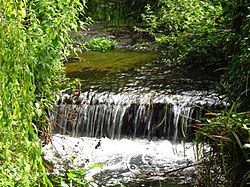
Back Riu Poddle Catalan Поддл CV Río Poddle Spanish Poddle ibaia EU ریور پادل FA Poddle Finnish An Poitéal GA Río Poddle GL پوڈل ندی PNB Поддл Russian
| River Poddle | |
|---|---|
 River Poddle at Poddle Park in Kimmage | |
 | |
| Nickname(s) | River Sáile[1][2] |
| Native name | An Poitéal (Irish) |
| Physical characteristics | |
| Source | |
| • location | Cookstown, near Tallaght, County Dublin[3] |
| Mouth | |
• location | Discharges into River Liffey at Wellington Quay[3] |
• coordinates | 53°20′44.5″N 06°15′56.3″W / 53.345694°N 6.265639°W |
| Basin features | |
| River system | River Liffey |
| Tributaries | |
| • left | Commons Water (Coombe Stream)[3] |
The River Poddle (Irish: An Poitéal) is a river in Dublin, Ireland, a pool of which (dubh linn, "black pool" or "dark pool" in Irish) gave the city its English language name. Boosted by a channel made by the Abbey of St. Thomas à Becket, taking water from the far larger River Dodder, the Poddle was the main source of drinking water for the city for more than 500 years, from the 1240s. The Poddle, which flows wholly within the traditional County Dublin, is one of around a hundred members of the River Liffey system (excluding the Dodder tributaries), and one of over 135 watercourses in the county;[4] it has just one significant natural tributary, the Commons Water from Crumlin.
The Poddle rises in the southwest of County Dublin, in the Cookstown area, northwest of Tallaght, in the county of South Dublin, and flows into the River Liffey at Wellington Quay in central Dublin. Flowing in the open almost to the Grand Canal at Harold's Cross, its lower reaches, including multiple connected artificial channels, are almost entirely culverted. Aside from supplying potable water for the city from the 13th century to the 18th, to homes, and to businesses including breweries and distilleries, the river also provided wash water for skinners, tanners and dyers. Its volume was boosted by a drawing off from the much larger River Dodder, it powered multiple mills, including flour, paper and iron production facilities, from at least the 12th century until the 20th. It also provided water for the moat at Dublin Castle, through the grounds of which it still runs underground.
The Poddle has frequently caused flooding, notably around St. Patrick's Cathedral, and for some centuries there was a commission of senior state and municipal officials to try to manage this, with the power to levy and collect a Poddle Tax. The flooding led both to the lack of a crypt at the cathedral and to the moving of the graves of satirist Dean Swift, author of Gulliver's Travels, and his friend Stella. The river and its associated watercourses were famously polluted in certain periods, at one point allegedly sufficiently so as to kill animals drinking the water. The river is mentioned briefly in James Joyce's novel Ulysses, and multiple times in Finnegans Wake, which mentions its role in Dublin's growth.
- ^ Healy, Mel (29 June 2016). "Down by the River Saile". Archived from the original on 24 August 2021. Retrieved 2 November 2020.
- ^ Cite error: The named reference
Hopkins_2008_Pdl_147was invoked but never defined (see the help page). - ^ a b c Cite error: The named reference
RSDubRgn_Poddlewas invoked but never defined (see the help page). - ^ Doyle, Joseph W. (January 2018). The Rivers and Streams of the Dublin Region. Dublin, Ireland: Rath Eanna Research. pp. 1 and 33. ISBN 978-0-9566363-8-6.